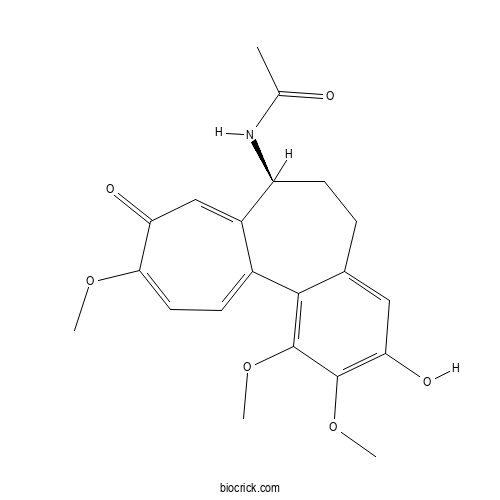(-)-3-DemethylcolchicineCAS# 7336-33-6 |

Quality Control & MSDS
3D structure
Package In Stock
Number of papers citing our products

| Cas No. | 7336-33-6 | SDF | Download SDF |
| PubChem ID | 299664.0 | Appearance | Powder |
| Formula | C21H23NO6 | M.Wt | 385.42 |
| Type of Compound | Alkaloids | Storage | Desiccate at -20°C |
| Solubility | Soluble in Chloroform,Dichloromethane,Ethyl Acetate,DMSO,Acetone,etc. | ||
| Chemical Name | N-[(7S)-3-hydroxy-1,2,10-trimethoxy-9-oxo-6,7-dihydro-5H-benzo[a]heptalen-7-yl]acetamide | ||
| SMILES | CC(=O)NC1CCC2=CC(=C(C(=C2C3=CC=C(C(=O)C=C13)OC)OC)OC)O | ||
| Standard InChIKey | JRRUSQGIRBEMRN-HNNXBMFYSA-N | ||
| Standard InChI | InChI=1S/C21H23NO6/c1-11(23)22-15-7-5-12-9-17(25)20(27-3)21(28-4)19(12)13-6-8-18(26-2)16(24)10-14(13)15/h6,8-10,15,25H,5,7H2,1-4H3,(H,22,23)/t15-/m0/s1 | ||
| General tips | For obtaining a higher solubility , please warm the tube at 37 ℃ and shake it in the ultrasonic bath for a while.Stock solution can be stored below -20℃ for several months. We recommend that you prepare and use the solution on the same day. However, if the test schedule requires, the stock solutions can be prepared in advance, and the stock solution must be sealed and stored below -20℃. In general, the stock solution can be kept for several months. Before use, we recommend that you leave the vial at room temperature for at least an hour before opening it. |
||
| About Packaging | 1. The packaging of the product may be reversed during transportation, cause the high purity compounds to adhere to the neck or cap of the vial.Take the vail out of its packaging and shake gently until the compounds fall to the bottom of the vial. 2. For liquid products, please centrifuge at 500xg to gather the liquid to the bottom of the vial. 3. Try to avoid loss or contamination during the experiment. |
||
| Shipping Condition | Packaging according to customer requirements(5mg, 10mg, 20mg and more). Ship via FedEx, DHL, UPS, EMS or other couriers with RT, or blue ice upon request. | ||

(-)-3-Demethylcolchicine Dilution Calculator

(-)-3-Demethylcolchicine Molarity Calculator
| 1 mg | 5 mg | 10 mg | 20 mg | 25 mg | |
| 1 mM | 2.5946 mL | 12.9729 mL | 25.9457 mL | 51.8914 mL | 64.8643 mL |
| 5 mM | 0.5189 mL | 2.5946 mL | 5.1891 mL | 10.3783 mL | 12.9729 mL |
| 10 mM | 0.2595 mL | 1.2973 mL | 2.5946 mL | 5.1891 mL | 6.4864 mL |
| 50 mM | 0.0519 mL | 0.2595 mL | 0.5189 mL | 1.0378 mL | 1.2973 mL |
| 100 mM | 0.0259 mL | 0.1297 mL | 0.2595 mL | 0.5189 mL | 0.6486 mL |
| * Note: If you are in the process of experiment, it's necessary to make the dilution ratios of the samples. The dilution data above is only for reference. Normally, it's can get a better solubility within lower of Concentrations. | |||||

Calcutta University

University of Minnesota

University of Maryland School of Medicine

University of Illinois at Chicago

The Ohio State University

University of Zurich

Harvard University

Colorado State University

Auburn University

Yale University

Worcester Polytechnic Institute

Washington State University

Stanford University

University of Leipzig

Universidade da Beira Interior

The Institute of Cancer Research

Heidelberg University

University of Amsterdam

University of Auckland

TsingHua University

The University of Michigan

Miami University

DRURY University

Jilin University

Fudan University

Wuhan University

Sun Yat-sen University

Universite de Paris

Deemed University

Auckland University

The University of Tokyo

Korea University
- Daucosterin acetate
Catalog No.:BCX1191
CAS No.:4282-00-2
- Deoxycytidine
Catalog No.:BCX1190
CAS No.:951-77-9
- Kissoone A
Catalog No.:BCX1189
CAS No.:903559-01-3
- Glycyrrhizic acid methyl ester
Catalog No.:BCX1188
CAS No.:104191-95-9
- Rubropunctamine
Catalog No.:BCX1187
CAS No.:514-66-9
- Neoisoliquiritigenin
Catalog No.:BCX1186
CAS No.:7014-39-3
- 6-Acetyl-7-hydroxy-2,3-dimethylchromone
Catalog No.:BCX1185
CAS No.:225518-70-7
- Heterophyllin J
Catalog No.:BCX1184
CAS No.:660397-15-9
- 5-Methoxyafrormosin 7-O-glucoside
Catalog No.:BCX1183
CAS No.:64656-92-4
- Acetylarenobufagin
Catalog No.:BCX1182
CAS No.:184673-79-8
- N-Acetyl-D-lactosamine
Catalog No.:BCX1181
CAS No.:32181-59-2
- GDP-L-Fuc.2Na
Catalog No.:BCX1180
CAS No.:15839-70-0
- Ludaconitine
Catalog No.:BCX1193
CAS No.:82144-72-7
- Syringopicroside
Catalog No.:BCX1194
CAS No.:29118-80-7
- Taccalonolide C
Catalog No.:BCX1195
CAS No.:117803-96-0
- Complanatuside 6"-malonate
Catalog No.:BCX1196
CAS No.:2089462-18-8
- Resinacein C
Catalog No.:BCX1197
CAS No.:1309931-92-7
- Markogenin
Catalog No.:BCX1198
CAS No.:562-35-6
- 4α-Phorbol
Catalog No.:BCX1199
CAS No.:26241-63-4
- Alltride
Catalog No.:BCX1200
CAS No.:2050-87-5
- 21-keto-gypenoside A
Catalog No.:BCX1201
CAS No.:1392136-41-2
- Tigogenin lactone
Catalog No.:BCX1202
CAS No.:514-33-0
- 8-Keto-berberine
Catalog No.:BCX1203
CAS No.:81397-08-2
- Isoproprotogracillin B
Catalog No.:BCX1204
CAS No.:117457-34-8
New colchicinoids from a native Jordanian meadow saffron, colchicum brachyphyllum: isolation of the first naturally occurring dextrorotatory colchicinoid.[Pubmed:15730238]
J Nat Prod. 2005 Feb;68(2):173-8.
As part of our continuing investigation of Jordanian Colchicum species, the biologically active components of Colchicum brachyphyllum were pursued. Using bioactivity-directed fractionation, nine colchicinoids were isolated and characterized. One of these has a novel ring system, to which we have ascribed the trivial name (+)-demecolcinone (9), and it represents the first naturally occurring dextrorotatory colchicinoid. Another isolated compound was a new colchicinoid analogue, (-)-2,3-didemethyldemecolcine (8), while the remaining seven known colchicinoids were new to the species: (-)-colchicine (1), (-)-3-Demethylcolchicine (2), (-)-cornigerine (3), beta-lumicolchicine (4), (-)-androbiphenyline (5), (-)-demecolcine (6), and (-)-3-demethyldemecolcine (7). The brine shrimp lethality test was used to direct the isolation of these colchicinoids. Moreover, all pure compounds were evaluated for cytotoxicity against a human cancer cell panel, for antimicrobial activity in an array of bacteria and fungi (including yeast), and for their potential to be allosteric modulators of the gamma-aminobutyric acid type A receptor.


